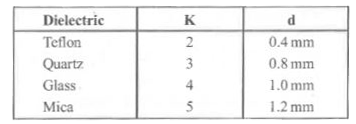A parallel plate capacitor has a plate separation of 2mm and use a dielectric (whose dielecric strength is 200kV/cm) as an insulator. The maximum potential difference that can be applied to the terminals of the capacitor is
10kV
20kV
30kV
40kV
The correct Answer is:D
Dielectric strength i.e., electric field at which insulator becomes conductor.
V=Ed=200×(210)=40kV
Topper's Solved these Questions
Similar Questions
A parallel plate capacitor has capacitor has a capacity of 6μF when dielectric medium separting the plates.
View SolutionThe is one parallel plate air capacitor having plate area 40 cm2 and separation between the plates equal to 0.1 mm. Dielectric strength of air is 3×106 V/m. find maximum rms voltage that can be applied across capacitor without electric breackdown.
View Solution
Knowledge Check
A parallel plate capacitor having a plate separation of 2mm is charged by connecting it to a 300V supply. The energy density is
A0.01J/m3B0.1J/m3C1.0J/m3D10J/m3The strength of a dielectric is defined as the maximum electric intensity which it can withstand. A paralel-plate capacitor of plate area A on one side is filled with a dielectric of strength E and permittivity ε. The maximum charge which can be given to the capacitor is
AεEABEA/εCE/εADεE/AA parallel plate capacitor of area ‘A’ plate separation ‘d’ is filled with two dielectrics as shown. What is the capacitance of the arrangement ?
 A3Kε0A4dB4Kε0A3dC(K+1)ε0A2dDK(K+3)ε0A2(K+1)d
A3Kε0A4dB4Kε0A3dC(K+1)ε0A2dDK(K+3)ε0A2(K+1)d
A 5.80μF parallel-plate air capacitor has a plate separation of 5.00mm and is charged to a potential difference of 400V. Calculate the energy density in the region between the plates, in Jm3
View SolutionA parallel plate capacitor is to be prepared by using plates of the same area, of one of the dielectric given below:

Which dielectric gives the maximum capacitance?
View SolutionTwo identical parallel plate capacitors are connected in series to a battery of 100V. A dielectric slab of dielectric constant 4.0 is inserted between the plates of second capacitor. The potential difference across the capacitors will now be respectively
View SolutionA parallel plate capacitor has a capacity c. If a medium of dielectric constant K is introduced between plates, the capacity of capacitor becomes
View SolutionA parallel -plate air capacitor has capacity C. A dielectric slab of dielectric constant K, whose thickness is half of the air gap between the plates, is now inserted between the plates. The capacity of the capacitor will now be
View Solution

